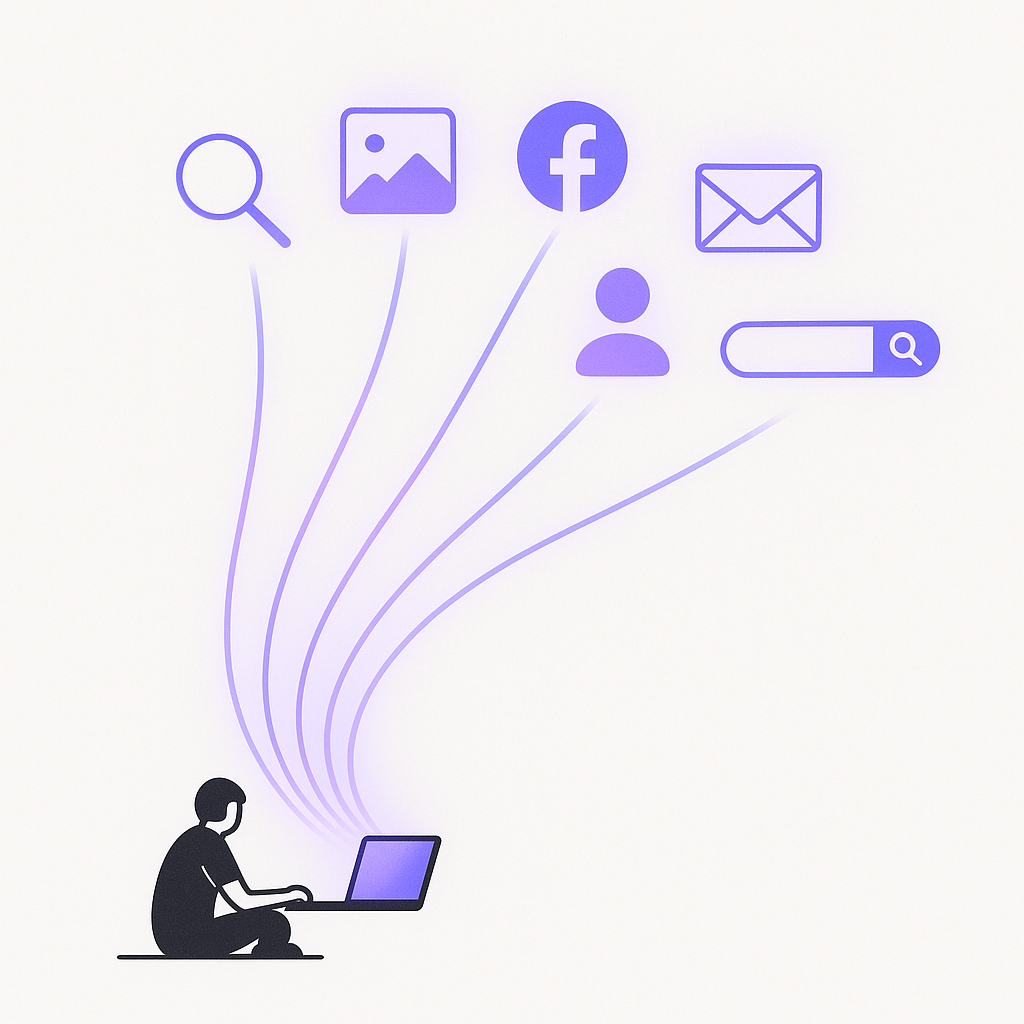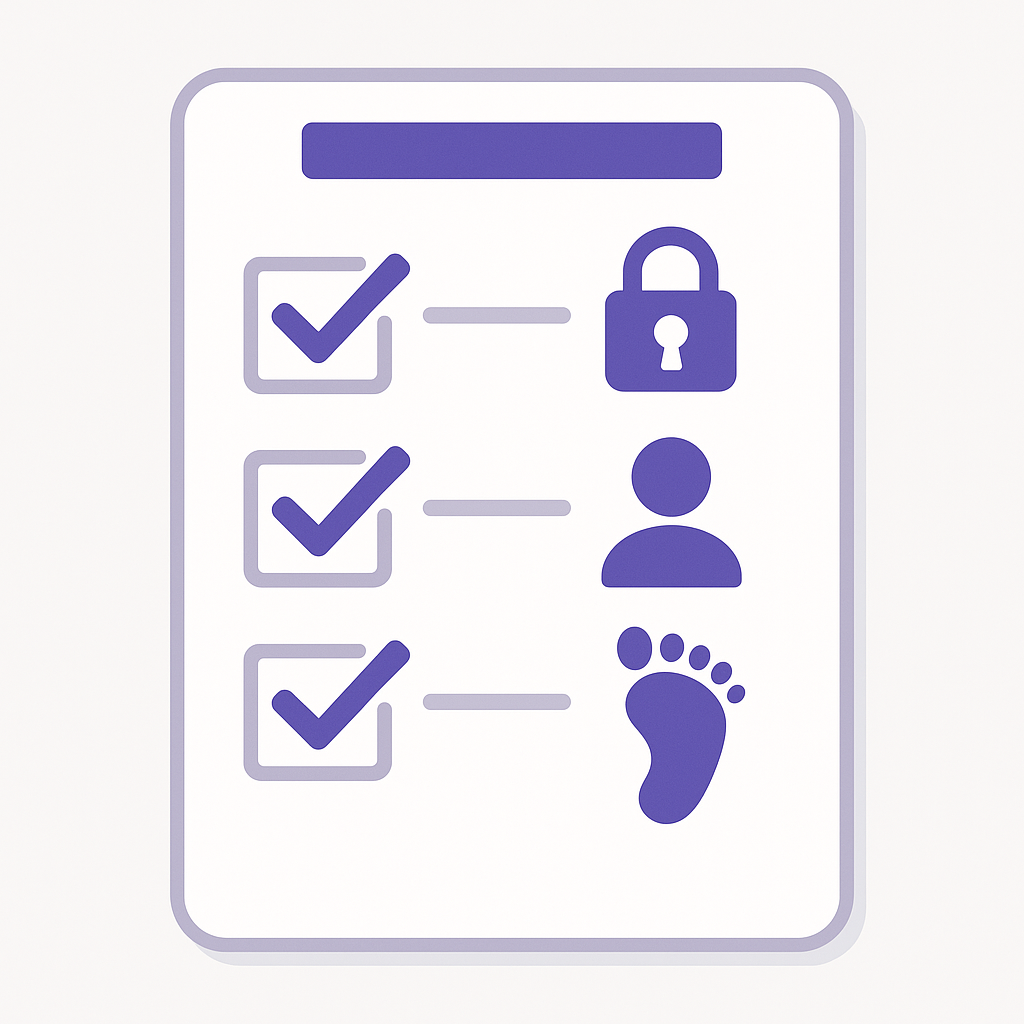Your digital footprint - the traces you leave online
Every time you use the internet, you leave small traces. This can be information you intentionally share - like photos, posts or comments - but also invisible data such as cookies, search history and location data that are saved automatically. All of this together makes up your digital footprint, and it can reveal a surprising amount about you.
Some traces are harmless, others can be sensitive. The better you understand how the footprint is created, the easier it becomes to control what is publicly available about you.
What makes up a digital footprint?
Your digital footprint can be divided into two main categories that cover almost everything that can be found about you online:
Active footprint - what you deliberately put out there. This includes everything from photos, videos, public social media posts, comments and likes to usernames, profiles on various websites, old blogs and forum posts. Anything you actively posted or registered for falls into this category. Many forget that even small interactions - like signing up for a newsletter - can create traces that live on for a long time.
Passive footprint - what is collected without you necessarily being aware of it. This includes your IP address, geographic location, login times, which pages you visit and for how long, tracking from cookies and apps, and data about your purchases, searches and clicks. This often happens in the background, and although the information may seem anonymous, it can be combined with other data to give an accurate picture of you.
The combination of active and passive footprints creates an extensive data trail that companies, authorities, hackers - and even future employers - can use to build a detailed image of your identity, interests and habits.

Why does your digital footprint matter?
Your digital traces can be used to make your online experience more personal - for example by saving preferences, giving you faster access to your favorite sites or showing you relevant offers. But the same amount of data can also be used for less harmless purposes.
Without your consent, the information can be used to profile you, create detailed consumer profiles, sell data to third parties or target political advertising. In the worst case, it can lead to identity theft, financial fraud or manipulation through social engineering. An old post from your younger days may suddenly appear when a future employer searches your name, or a picture can be taken out of context and shared beyond your control.
Moreover, digital footprints are increasingly used by algorithms to make decisions about you - everything from which news you see to whether you get approved for a loan. Lack of awareness of your footprint can therefore have long-term consequences that go far beyond mere privacy protection.

How to discover what's out there about you (part 1)
The first step toward control is to map your online presence. Start by searching for yourself:
- Use your full name, middle names, email addresses, old usernames and any aliases.
- Run image searches to see if your pictures are used without your knowledge.
- Review old profiles on social media, blogs and forums - even ones you haven't used for years.
- Check the privacy settings on the platforms you still use.
Then expand the search to include combinations of information, such as name + city, email + workplace or username + interest. You'll often find traces you had forgotten - old comments on news articles, profiles on niche forums or pictures that have been shared further. This thorough mapping forms the foundation for taking control of your footprint.
How to discover what's out there about you (part 2)
There are a number of tools and services that can help you get an even better overview:
- HaveIBeenPwned.com - check if your email has been compromised in a data breach and see which data was leaked.
- JustDelete.me - guides you through deleting old accounts, even those with complicated opt-out processes.
- Google Takeout - gives you a complete copy of the information Google has about you, including search history, maps data and emails.
- Privacy tools like Ghostery or Disconnect that show who is tracking you.
- Security scanners that can find and warn about exposed information in open databases or on the dark web.
Make it a habit to search for yourself a couple of times a year and repeat this scan. Small, regular checks give you the opportunity to act quickly if unwanted information appears - and the sooner you act, the easier it is to limit the spread.
How to minimize your digital footprint
Even though you can't delete everything, you can do a lot to reduce the amount of public information:
- Share less - ask yourself whether the content needs to be publicly available.
- Make sure social media profiles are private and limit who can see your posts.
- Use different usernames and emails for different purposes - e.g. one for work, one for personal use and one for sign-ups/competitions.
- Disable unnecessary tracking and location sharing in apps and services.
- Avoid using “Login with Facebook/Google” as it links your data across platforms.
- Use privacy-friendly search engines like DuckDuckGo or Startpage.
- Delete old posts, accounts and apps you no longer use, and clean up regularly.
These measures are not only about removing existing data but also about preventing future traces.

The hidden risk of old data
Old information rarely disappears completely. Even if you delete it from a platform, it may still exist in web archives, on other people's hard drives or in backups. A picture you removed years ago may have been saved by another user. A forum post may exist in a cache accessible through search engines.
In addition, your data may have been sold to data brokers who collect and resell information for marketing, credit scoring or political analysis. This means that even “forgotten” data can resurface many years later. That's why it's important to combine deletion with prevention so you don't keep creating new traces that may come back to cause problems.

When privacy becomes a habit
Protecting your footprint requires ongoing attention. Think of it as a form of digital hygiene: the more often you “clean” your information and check what's visible, the lower the risk of misuse or misinformation being spread.
Consider building small routines into your everyday life - such as reviewing privacy settings before installing new apps or checking how your name appears online before sending an important job application. These small steps quickly become a natural part of your online behavior and give you a sense of control over your digital identity.
Owning your digital identity
Your digital footprint is part of your identity in the online world. It's not about hiding, but about being in control. By being conscious of what you share and who can see it, you can minimize risks while still using the internet with confidence. Small actions today can prevent big problems tomorrow.